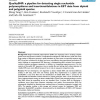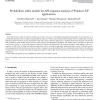95 search results - page 8 / 19 » Detecting Motifs in System Call Sequences |
ITCC
2005
IEEE
14 years 1 months ago
2005
IEEE
Abstract: Evidence of some attacks can be manifested by abnormal sequences of system calls of programs. Most approaches that have been developed so far mainly concentrate on some p...
BMCBI
2006
13 years 7 months ago
2006
Background: Single nucleotide polymorphisms (SNPs) are important tools in studying complex genetic traits and genome evolution. Computational strategies for SNP discovery make use...
ISMB
1994
13 years 8 months ago
1994
A new version of the GRAIL system (Uberbacher and Mural, 1991; Mural et al., 1992; Uberbacher et al., 1993), called GRAILII, has recently been developed (Xu et al., 1994). GRAILII...
PR
2008
13 years 7 months ago
2008
Given the pervasive nature of malicious mobile code (viruses, worms, etc.), developing statistical/structural models of code execution is of considerable importance. We investigat...
BMCBI
2010
13 years 7 months ago
2010
Background: Primer and probe sequences are the main components of nucleic acid-based detection systems. Biologists use primers and probes for different tasks, some related to the ...


